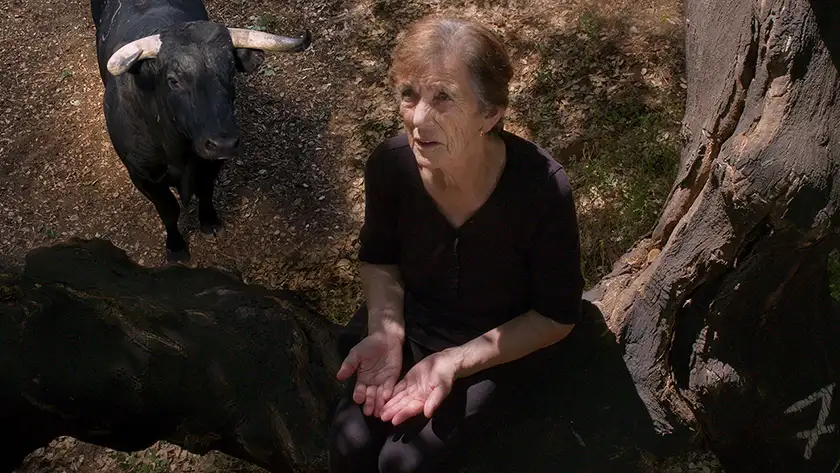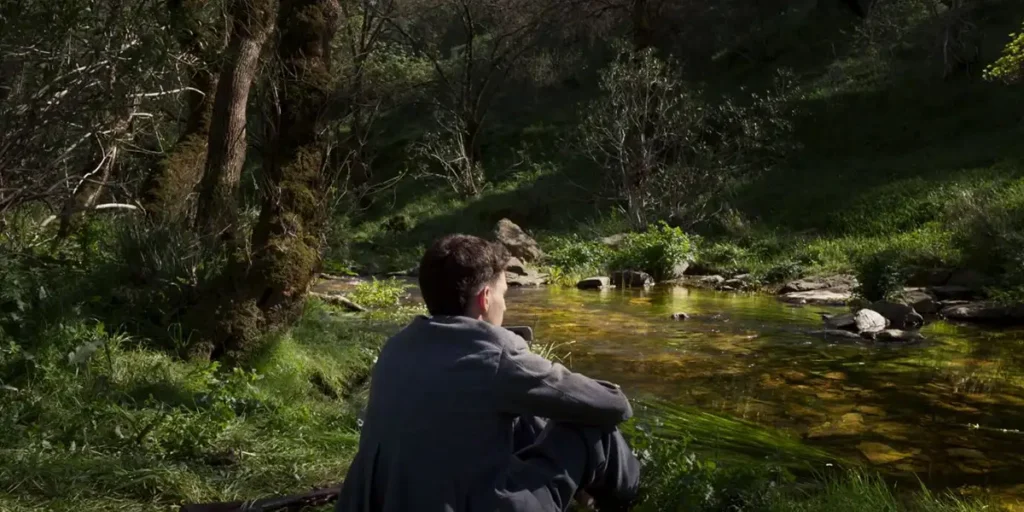Marta Mateus’ Fire of Wind contains imagery that is pretty to the eye, yet the filmmaker remains static in her vision.
Director: Marta Mateus
Genre: Drama
Run Time: 72′
Language: Portuguese with English subtitles
New York Film Festival Premiere: September 28-29, 2024
BFI London Film Festival Screening: October 19-20, 2024
U.S. Release Date: TBA
U.K. Release Date: TBA
Vineyard workers are trapped in dreams and memories in Marta Mateus’ feature-length debut, Fire of Wind (Fogo do Vento), which was screened at the New York Film Festival in the Currents section. The earth beneath their feet contorts into a mythological playground embalmed in magical realism as the nature surrounding them creates a dreamy and sometimes ominous atmosphere. The Portuguese filmmaker, known for her short Barbs, Wastelands, has a penchant for the meditative through the landscapes in which her projects are set. She basks in the beauty of the flowers, leaves, trees, and plains as her characters reflect the region’s history – the stories from the past that forged the locals’ existence.
Much like her 2017 short, Fire of Wind is a fable about the circumstances the working class faced back in the 20th Century following Oliveira Salazar’s dictatorship. Set in Portugal near the Alentejo region, the film centers around vineyard workers in a peasant community whose methods of harvesting grapes by hand are in the process of being replaced by machines. These machines might do the same work as the locals at a faster rate and more profitable means. But this modern technology does not know the land. Only the people raised in the region value the dirt on which the grapes grow, the leaves falling from the trees, or the beautiful flowers covering their gardens – the beauty and complexion of nature.
In both their themes and structure, these initial moments reminded me of a Portuguese film that was screened at Cannes this year, Paulo Carneiro’s Savanna and the Mountain (A savana e a montanha). Like Mateus’ feature, it is a portrait of a small town crumbling because of modernization, demonstrated through dashes of magical realism to tie the past with the now fractured present. While Carneiro adds folk songs to channel the rebellious tone of the locals’ frustrations and worries, Mateus remains more poised and less “out there” tonally with a more grounded approach to the hex behind the small town where Fire of Wind is set.
One of the few workers we get to meet by name is a young woman named Soraia (Soraia Prudêncio). She accidentally sets up a chain of events that will transport the villagers and other workers to a dream state in which memories of a past before them are conjured into the world. Soraia cuts her hands on some shears, with the blood dripping onto the soil and leaves near her. We don’t see the damage the shears have done, but the trail of her blood is marked onto the land they ought to keep as sacred. And this marking on the ground seeks the attention of a runaway black bull. The townsfolk are utterly worried as the bull rampages through the village.

With nowhere else to run, they head toward the oak trees, awaiting someone to help them slay the loose beast. The workers and villagers spend the entire night hidden above the trees. When morning comes, something strange occurs. They may not perceive it immediately. But there is a peculiar sensation in the air; a spell has been placed in the Alentejo region. At this moment, Mateus provides Fire of Wind with an intangible atmosphere that reflects on the development of Portugal through the years, before and after Salazar’s dictatorship.
Time and space shift in the first act of Mateus’ feature-length debut. The villagers’ recollections, and those picked upon the land, are now being personified via returning figures, scriptures, and other things that remind them about the past, whether similar smells or sights. Their thoughts are read out loud; memories are shared visually, not vocally. These villagers are stuck in limbo, constructed in a grounded manner by Mateus, which causes the magical realism smeared across her canvas to feel more vivid and dreamy. She also leaves space for the audience, and the characters as well, to immerse themselves in this time-shifting scenery where everything might look the same, but the wind that blows catches them off guard.
These spaces are very long-lasting, which nicely pairs with some other meditative pieces playing at the festival, like The Ballad of Suzanne Césaire, You Burn Me, or Seven Walks with Mark Brown. But, unlike the aforementioned, I don’t think Fire of Wind benefits from this stillness behind the camera, as its story loses fervor. Captured by cinematographer Vitor Carvalho and Mateus, the images in the film are shaped by real-life events that plague the Alentejo area of Portugal to this day, hence its reliance on showing old photographs, letters, and many other objects that show how deep the wound goes.
The problem is that there is not much after that straightforward messaging. Maetus does not play with her concept of a personified version of reminiscence and longing for a better life for the villagers and the ones after them – the children of Soraia and the next generation who grew up in that looked-after land. Its structure relies on the same camera maneuvers, mostly static shots and few edits. Initially, these images capture the magic of past and present blending. Gradually, you see there aren’t more ways to depict or bring Mateus’ worries about her hometown to cinematic life. I admire how she alludes to these issues, unknown to the majority of the public, via an occasionally poetic manner and comes up with many pretty-to-the-eye sequences. But a part of me still feels Mateus’ statement in the core of Fire of Wind is stuck in that static way the camera rolls: never moving along. It could be more substantial if Mateus were more playful with the visual language rather than with a singular vision.
Fire of Wind had its North American Premiere at the New York Film Festival on September 28-29, 2024 and will be screened at the BFI London Film Festival on October 19-20, 2024.

